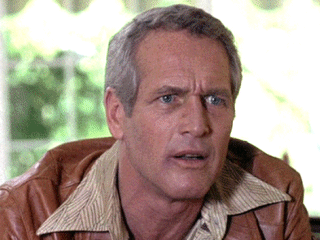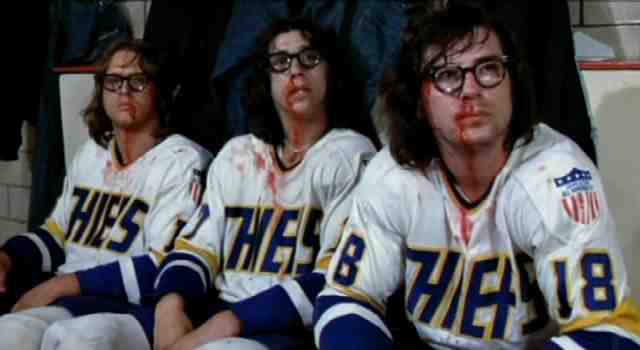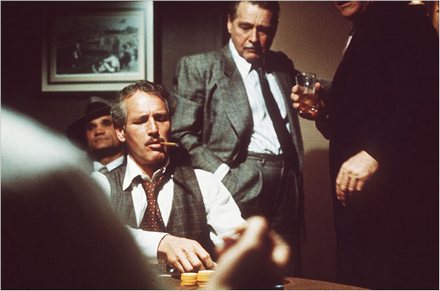 George Roy Hill and Paul Newman scored two mega-hit, crowd pleasing films with Butch Cassidy and the Sundance Kid and The Sting (Recommended by Johann Koehler here). When they reunited in 1977, the commercial temptation would have been to more or less repeat themselves. Being highly creative artists, they instead challenged many of their fans’ expectations by making a foul-mouthed, violent, raunchy comedy set during America’s dreary blue collar decline: 1977’s Slap Shot.
George Roy Hill and Paul Newman scored two mega-hit, crowd pleasing films with Butch Cassidy and the Sundance Kid and The Sting (Recommended by Johann Koehler here). When they reunited in 1977, the commercial temptation would have been to more or less repeat themselves. Being highly creative artists, they instead challenged many of their fans’ expectations by making a foul-mouthed, violent, raunchy comedy set during America’s dreary blue collar decline: 1977’s Slap Shot.
Some (though not all) viewers were appalled. But, with critic Gene Siskel being the most well-known example, reactions to Slap Shot have warmed over time to the point that it is today justly regarded as a classic American movie.
The plot: The Chiefs are a minor league hockey team who lose more than they win under aging player-coach Reggie Dunlop (Newman). Meanwhile, the local plant is closing, leading the team’s owner (Strother Martin) to shop the franchise around. His career and marriage on the rocks, Dunlop knows he needs to gin up some victories and some interest for the team. The answer comes in the form of the Hanson brothers, who lead the team into a new style of hockey: Beating the crap out of their opponents! The dirty play pays off as The Chiefs start to win and the fans begin to rally around them. Meanwhile, there is lots of 1970s bed-hopping and retrograde attitudes under threat.
Some may be surprised that the script was written by a woman. But Nancy Dowd, whose brother was a minor league hockey player, knows her way around the game and also around people who use language that would make a sailor’s parrot blush. Hockey fans love the authenticity of the film, not least that Michael Ontkean (As a clean-cut Princeton grad who is the star of The Chiefs and disapproves of dirty play) and many of the other performers were in fact excellent hockey players. The resulting film is funny, rude, politically incorrect and a jolly good time. Having lived myself though the 1970s de-industrialization of Western Pennsylvania and seen all the leather suits, huge shirt collars, towering heels and other fashion horrors I can vouch for this film’s accuracy about life at the time.
 Newman, in a role that was a stretch for him (he apparently rarely even swore in private life), gives a very appealing comic performance as an over-the-hill jock. He also has great byplay with his frequent co-star Strother Martin and with Jennifer Warren as his ex-wife. Andrew Duncan is hilarious as a radio announcer with hair from hell. Lindsay Crouse, as Ontkean’s binge drinking wife, delivers a one-note and eventually tedious performance, but all of the other smaller parts are well-turned by the actors.
Newman, in a role that was a stretch for him (he apparently rarely even swore in private life), gives a very appealing comic performance as an over-the-hill jock. He also has great byplay with his frequent co-star Strother Martin and with Jennifer Warren as his ex-wife. Andrew Duncan is hilarious as a radio announcer with hair from hell. Lindsay Crouse, as Ontkean’s binge drinking wife, delivers a one-note and eventually tedious performance, but all of the other smaller parts are well-turned by the actors.
Last but not least, the scenes of the hockey games are very well done. Everyone can skate and the crushing impacts and high-velocity shots feel real.
Slap Shot will never be shown at a church social or at a gathering of anti-violence activists. As long as that doesn’t put you off, get ready to laugh and be enormously entertained.
p.s. Some fun trivia: can you name ALL the films that Newman and Martin were in together? Martin’s Wikipedia entry claims six such pairings, but I could only come up with five so I am either forgetting one or *gasp* Wikipedia is wrong about something.
